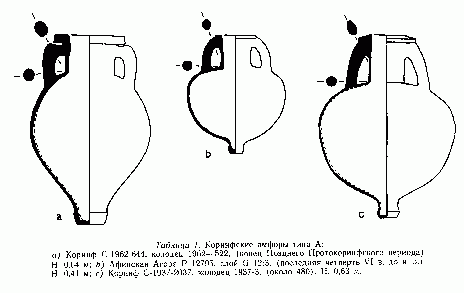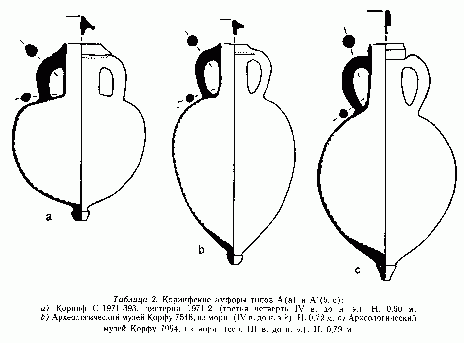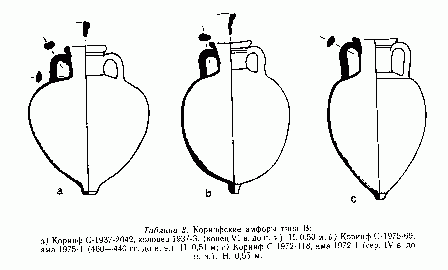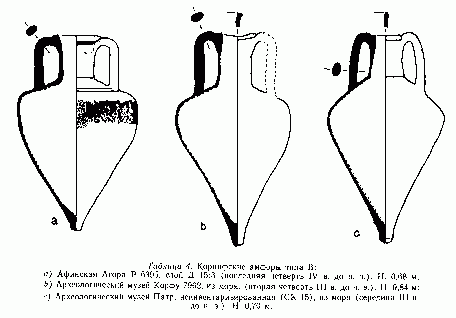
Go to:
Note: this article was originally published in Russian in the collection Greek Amphoras (Saratov 1992). We are grateful to the editors, V.I. Kats and S.Iu Monakhov, for permission to reproduce it here. The text is the English text submitted for publication, with some corrections.
Corinth is now recognized as one of a number of Greek city-states known to have made and exported the large, coarseware jars used for the storage and transportation of commodities in bulk.[1] Corinthian amphoras are not mentioned in the ancient literature, but archaeological evidence has made possible the identification of as many as three classes that can be linked with that ancient emporium. Two of these, termed Corinthian A and A', which are related in style, in their method of manufacture, and sometimes in fabric, have been securely attributed to Corinth. There is some evidence that the third class, known as Corinthian Type B, was also produced at Corinth, although the Corinthian colony of Corcyra seems to have manufactured at least some jars in this series. Here follows a summary definition of each type and a chronological outline of their development in shape, with general indications of their distribution.

Type A amphoras grew out of the tradition at Corinth that produced large, globular storage jars in the Geometric period.[2] By the end of the 8th century B.C., the Corinthian A jar is distinguishable from other containers by its elongated, cylindrical toe and its vertical handles, which made it maneuverable. The class is also characterized visually by a roughly spherical body, a broad, flat rim, and heavy handles (Pl. 1:a-c, Pl. 2:a). Until the end of their production about 300 B.C., Corinthian A jars were largely hand-built, which seems to be exceptional for transport amphoras in the Archaic and Classical periods.[3]
Throughout its period of manufacture, the fabric of Corinthian A is strikingly uniform and can easily be recognized by its reddish color and large, angular inclusions. It is very hard, sometimes almost vitreous, with an extremely fine clay matrix containing quartz silt and chert.[4] Most often the core is gray (5YR 6/1) with outer reddish layers (2.5YR 6/6 to 7.5 YR 7/6), but the cross-section can be all red or all gray.[5] External surfaces are usually a lighter pinkish-orange (7.5YR 7/4 to 7/6). In the second half of the 4th century (and sometimes earlier), a wash of an iron-rich material was painted or wiped on the exterior and occasionally on the upper neck interior in striking swirls of deep red or dark gray.[6]
The numerous and distinctive red and gray inclusions in Corinthian A fabric, which average 1--2 mm. in size, have been identified by petrological analysis as mudstone and tuffite containing microfossils of radiolaria. Such inclusions have also been identified in roof tiles found in kilns at Corinth, as well as in terracotta sculptures and local coarsewares such as perirrhanteria and hydriai. The sources of this temper have been located in the immediate vicinity of ancient Corinth, including prominent outcrops on Acrocorinth.[7]
Corinthian A jars accompanied the numerous other exports shipped from Corinth to the west during the period of Greek expansion in the later 8th and 7th centuries B.C. In fact, the chronology of the beginning stages of shape for Type A depends chiefly upon examples excavated at coastal settlements around southeast and central Sicily and in Magna Graecia. Most of these have been recovered from cemeteries, where such containers were frequently reused as cinerary urns or as coffins for infants. Jars found with grave offerings of Protocorinthian pottery at Schirone near Metaponto and at Gela establish the Corinthian A amphora series as one of the first produced in Greece.[8]
The next stage of development is represented by a Type A jar found in a stratified well deposit of the third quarter of the 7th century (Pl. 1:a).[9] Considerable skill and care were expended in precise trimming of rim and bevelled cap toe, qualities which marked the many diverse products of the Corinthian ceramics industry which flourished at this period. Amphoras very like this one appear at Camarina on the southeastern coast of Sicily at the time of its foundation a quarter of a century later and other jars from the Archaic cemetery there indicate the evolution in shape of Type A throughout the 6th century B.C.[10]
Other finds at Corinth mark sixth-century stages in the trend toward a more sharply curving body, a narrower toe and neck, and a less massive rim.[11] By the beginning of the 5th century, these tendencies result in the slightly flattened shoulder of the small Type A amphora from a well in the Athenian Agora (Pl. 1:b).[12] Its cylindrical toe is distinct in profile from the body, and its handles are slightly pinched at the top, so that their section is no longer round but increasingly ovoid. Larger counterparts of this amphora were widely exported throughout the Greek world in the later 6th and early 5th centuries, as finds from Gela to the Elizavetovskoe settlement on the Don demonstrate.[13]
In the first quarter of the 5th century, the upper surface of the horizontal Type A rim begins to slant down (Pl. 1:c); by the mid-fifth century, the handles, now more sharply pinched at the top, are occasionally stamped at the base with a palmette.[14] The generally spherical shape of the body on Type A jars continues to the end of their manufacture at the close of the 4th century (Pl. 2:a).[15] Immediately recognizable characteristics of such jars are a peg toe (which provides a firm grip for lifting) and a heavier, overhanging rim which rests on the spiny top edge of the handles. In section the handles are triangular or teardrop-shaped at the top and round or slightly oval at the bottom. A palmette is sometimes stamped at the base of one or both handles in the second half of the 4th century; occasionally a single letter or monogram appears on the upper flat side of either handle.[16] Nearly all Corinthian A jars known of the 5th and 4th centuries have been found at Corinth.

Corinthian Type A' (Pl. 2:b, c) was isolated as a distinct class of amphoras when numerous fragmentary examples were excavated in a fifth-century establishment at Corinth known as the Punic Amphora Building.[17] Type A' can be differentiated from Type A in the ovoid shape of its body and, particularly after the middle of the 5th century, in its fabric. It shares with Type A, however, an overall similarity of shape and in particular the broad, sloping rim; the method of construction by hand; and, before the mid-fifth century, sometimes also the same clay and/or mudstone inclusions.[18] Appearing alongside Corinthian A at least by the early 5th century B.C., Type A' continued through the 4th century and apparently replaced Type A in the 3rd and 2nd centuries B.C. It seems to have functioned largely as an export container, ending up, like Corinthian A jars in an earlier period, primarily in Sicily and Magna Graecia.
Generally speaking, Type A' jars are related in fabric to most of the common types of Corinthian ceramics; with the exception of some in the earliest decades of their production, they are made of fine yellow clay and the usual inclusions after the mid-fifth century are fine quartz sand, chert, and lime.[19] The surface of Corinthian A' jars is light pink to light yellow (ranging from 10YR 8/2 to 10YR 8/3 to 7.5YR 7/4) and exhibits no treatment beyond the final wiping or smoothing. In cross-section the color is generally pink (5YR 8/4 to 7.5YR 7/4); often there is an outer layer of the same color as the surface.
Corinthian A' jars show some evolution of form, although after the middle of the 5th century the lack of well dated excavation contexts and the profusion of variations makes it hard to establish a clear linear development.[20] In the later 5th and the 4th centuries, the slope of the overhanging rim gradually steepens, as on contemporary Type A jars. The neck narrows and the high shoulder broadens (Pl. 2:b). Handles are curved in plan and round in diameter, decreasing in size toward the bottom. Stamps on the handles are infrequent in this period, but there are a few, some similar to those found on Type A.[21]
In the beginning of the 3rd century, the production of Type A' seems to have expanded, even as that of Corinthian A ceased. Numerous fragments of such amphoras which were found (together with Type B jars) in a shipwrecked cargo at Stentinello near Syracuse and another at Savelletri near Brindisi suggest extensive Corinthian exports in the first half of the 3rd century B.C. and show further stylistic evolution.[22] The point of maximum diameter on the ovoid body of Corinthian A' has dropped to the center; the cap toe is conical. Gradually the slant of the rim steepens and acquires a bevel at about its midpoint. The latest pieces from the Savelletri cargo, which are similar to a jar from Corfu (Pl. 2:c), demonstrate that by the middle of the 3rd century the collarlike rim is nearly vertical, the neck flared toward the bottom, and the toe enlarged, with compound curve in profile. Stamps occur rarely and include three names.[23]

Corinthian Type B amphoras are marked by a more or less ovoid body, a flaring rim, and vertical, arched handles (Pl. 3, Pl. 4). These jars were manufactured from about 525 to at least the late 3rd century and probably into the 2nd century B.C. Type B jars were exported primarily to the west, and are found at many sites where Type A and A' jars have been recovered.
Corinthian B fabric is generally light in color and fine in texture. Petrological analysis has shown that throughout their production Type B jars were made predominantly of the yellow clay that characterizes most Corinthian ceramics; surface and interior are usually light pink to light brownish yellow (5YR 8/4 to 7.5YR 7/4). After the third quarter of the 4th century, however, some appear instead in a fabric that is similar to the first but light reddish-brown in color (2.5YR 6/6). Inclusions are mostly small ones of quartz and chert, with no mudstone or tuffite; small voids or pores are often noticeable in cross-section.[24] The surface of jars made from yellow clay is finished simply by wiping or smoothing, but the reddish-brown jars of the first half of the 3rd century are usually covered with a pale buff slip.
Originally the Type B series was tentatively assigned by
Virginia Grace to the Corinthian colony of Corcyra.[25] An ancient source that has come down to us as
part of the Aristotelian corpus describes a centralized market in
northern Greece to which merchants come from the Pontus with Lesbian,
Chian, and Thasian goods, and others from the Adriatic with Corcyraean
amphoras.[26] The relatively small
number of Corinthian B jars and stamped handles found on Corfu and in
the waters around it were candidates for the class to which he
referred, since very few amphoras of any other type had been excavated
on the island. Nevertheless, although
More recent analyses using optical emission and Mössbauer spectroscopy have separated Type B jars into two fabric groups on the basis of (respectively) chemical composition and the nature of the iron in the clay. Those results linked some of the test group of amphoras with the control group of coarsewares from Corinth, as had the neutron activation study, but they also matched other Type B jars with coarse pottery made on Corfu. The two techniques did not assign individual jars to the same group in every case, but the general conclusion was clear: at least some Corinthian B jars were made in Corcyra from the Archaic period through the early 3rd century, at the same time that they were being produced in Corinth.[28]
The two groups of Type B amphoras established by physico-chemical analyses can not be distinguished either stylistically or petrologically; further evidence is needed for a complete explanation of the manufacture of the Corinthian B series.[29] Very recent excavations in a potters' quarter on Corfu offer direct evidence for the attribution of at least some Corinthian Type B jars. A large area with several kilns has revealed quantities of fragments and kiln wasters of Type B amphoras which date from the second half of the 5th to the mid-third centuries B.C.[30] This does not rule out the possibility that Type B jars were also made at Corinth. In any case, the many examples from shipwrecks and other sites show that Corinthian A, A' and B jars were often shipped together; the network of distribution, at the least, seems linked to Corinth. Until the relationship of Corinth and its colony of Corcyra in the matter of production and export of these containers can be more fully explained, it seems best to retain the current nomenclature for the series.
Amphoras of the Corinthian B series exhibit a quite regular evolution of profile. Numerous jars and fragments dated by context at both Corinth and Athens attest the shape of the earliest Type B jars, which belong to the last quarter of the 6th century B.C. (Pl. 3:a).[31] Already several characteristics of the class are clearly defined: the rounded, outward-thickened rim, the ridge or offset band around the top of the neck, and the arching, vertical handles. About 480 B.C., the cylindrical toe becomes smaller and the rim flared; by the middle of the 5th century the body is ovoid and the toe a conical cap (Pl. 3:b).[32] Such jars were exported to many sites in Greece and also in the west.[33]

From this point on, the body of Corinthian B amphoras gradually lengthens and narrows, following a tendency general for most transport amphoras throughout the Greek period. From the beginning of the 4th century, the toe is formed together with the body and continues its line, although initially it is articulated by a deep groove (Pl. 3:c).[34] By the end of the 4th century, neck and handles are taller, and the elongation of the body is even more pronounced (Pl. 4:a).[35] Often a wide band of shallow grooves accentuates the broad, high shoulder, possibly the impression made by a girdle of sticks as the vessel dried.[36] The upper neck, still with a ridge or groove (or two) around its top, is oval and the flaring rim is pinched where it rises over the handles, so that in plan view it often resembles a figure-eight.[37]
The still more exaggeratedly piriform body of the jar in Pl. 4:b can probably be dated toward the end of the first quarter of the 3rd century B.C., since it seems to be a slightly later stylistic stage than the 18 Type B jars from a deposit buried in the destruction of Gela in 280 B.C.[38] Its shoulder slopes somewhat more, and the rim, although still flared, is more compact and has an almost triangular section. The latest of the Corinthian B necks from the Stentinello wreck are approximately contemporary with the important group at Gela; somewhat later still and datable to the second quarter of the 3rd century are the pieces from the shipwreck at Savelletri.[39] These and other groups in the west show that the period of greatest export of Corinthian B amphoras was in the latter part of the 4th and first half of the 3rd century B.C.[40] On the Corinthian B jar tops from Savelletri, the rim shortens to a roll, above which the heavy handles arch, and the toe develops a slight bulge at its tip. At about the middle of the 3rd century, the point of maximum diameter drops well below the shoulder, as illustrated by the biconical body on an intact find in Patras from the sea (Pl. 4:c).[41]
Not much later there is a major, perhaps abrupt, change in Corinthian B jars: The shoulder becomes less angular and the neck smaller in proportion to the whole body, with a small rim that is semi-circular in section. Most strikingly, the handles now lose their arch and attach below the rim.[42] Examples of this latest stage in the development of Type B have appeared recently in excavations at Corinth but cannot be dated more closely than the mid-third to second century B.C.; presumably their production ceased when the Romans under Mummius sacked the city in 146.
Stamps appear on some Corinthian B jars primarily after the middle of the 4th century, impressed either on the top of the curve of the handle or at its lower attachment. More jars seem to have been stamped in the late 4th and early 3rd centuries; for instance, 8 of 18 Type B amphoras in the deposit at Gela bear stamps. Some 400 different dies are known. Generally, single letters, ligatures, or simple monograms were impressed on the top of a handle or at its base, but small pictorial devices were also popular.43 These are likely to be potter's marks, but their significance remains uncertain. Dipinti, nearly always in red and showing one to three letters, a ligature, or a monogram, occur with some regularity.
There is little mention of commodities that might have been
carried in the jars of these three series; wine and oil are the most
obvious candidates. The reputation of Corinthian wine suggests that it
would have been exported strictly as vin ordinaire: Athenaeus
quotes Alexis, a poet of Middle Comedy, as despising Corinthian wine
as hard (
Analyses using gas chromatography have not to date identified organic material representing the original contents of A, A' or B amphoras. A very tentative hypothesis or two may be suggested, however. It is possible that Corinthian B carried wine, since Type B jars were coated on the interior with a resinous substance which kept the liquid from soaking into the porous fabric of the container, a practice known to have been used for jars that carried wine or semi-liquid contents (but not oil).[46] In turn, the fabric of Type A jars can be associated with that of oil-carrying lekythoi, lamps, and other vessels of the 5th and 4th centuries made at Corinth of blisterware, a clay related to that of Type A.[47] Certainly the hardness of blisterware vessels and of Corinthian A jars was well adapted to withstand erosion caused by oil, and their impermeable walls would not have required any lining.[48] Type A' jars, on the other hand, were permeable and would have had to be coated with resin, beeswax or some other substance that would not have spoiled the contents. No trace of a lining on Corinthian A' amphoras is known.
Direct measurements of capacity have been taken for together nearly 200 jars of the three Corinthian types.[49] For some amphora classes in some periods a size or series of sizes can be recovered, but sizes have not been recovered for Corinthian A and A'.[50] Type A jars are on the whole much larger than those of other Greek amphora series; in all periods they held various amounts, the smallest about 18 liters, the largest 70, and the majority above 40. Type A' jars range in size from roughly 18 to 50 liters. With Corinthian B amphoras, however, the results have been more promising. Their span for the entire period of production is 19.3 to 27.6 liters, with some jars of a much smaller size, but for the early 3rd century Corinthian B jars seem to have achieved a certain intended size. Ten jars at Gela from the deposit in the Via Polieno (see above) which were measured with water held a mean of 25.0 liters +/- one standard deviation of 0.995 liter. Further measurements of chronological groups of intact Corinthian A, A' and B amphoras, when these are available, will determine whether there were "normal" sizes for Type A and A' jars as well, and for Type B jars in other periods.
Corinthian amphoras furnish important evidence about the economics and trade not only of Corinth but of the wider Greek world as well. I.B. Brashinskii and I.B. Zeest have shown that they formed at least some part of exports to the Black Sea and other areas to the northeast of the Greek mainland. Corinthian jas have not been identified hitherto in any great amount in these regions, but it is hoped that this survey will help to bring about an assessment of their role in such trade.
The results of the author's study of Corinthian amphoras first appeared as Corinthian A and B Transport Amphoras (Ph.D. dissertation, Princeton University 1978). In updated form the full work will soon appear as Corinthian Transport Amphoras.
The following, with the short references used when they appear in this article, are interim publications on various aspects of the topic: "Corinthian Developments in the Study of Trade in the Fifth Century," Hesperia 50 (1981) 449--458 = Koehler 1981; "Amphoras on Amphoras," Hesperia 51 (1982) 284--292 = Koehler 1982; P.B. Vandiver and C.G. Koehler, "Structure, Processing, Properties and Style of Corinthian Transport Amphoras," in W.D. Kingery, ed., Technology and Style Ceramics and Civilization 2 (Columbus, Ohio 1986) 173--215 (Vandiver and Koehler 1986); I.K. Whitbread, The Application of Ceramic Petrology to the Study of Ancient Greek Transport Amphorae, with Special Reference to Corinthian Amphora Production (Ph.D. Dissertation, University of Southampton 1986) = Whitbread diss.